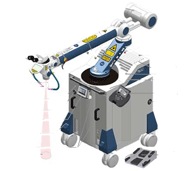Application of Laser Thermocycling to Improve the Quality of Plasma Wear-Resistant Coatings
DOI:
https://doi.org/10.20535/2521-1943.2022.6.3.268173Keywords:
plasma coating, laser thermocycling, irradiation, heating, bond strength, metallurgical bond, wear resistanceAbstract
The problem of the article is designed to reveal the proposed, developed and researched new method of improving the adhesion strength of plasma wear-resistant coatings on the outer surfaces of weapons made of high-alloy, heat-resistant steels, using additional cyclic (3-4) times their heating by laser radiation to temperatures of 0.6 – 0.8Tpl for a few milliseconds.
The purpose of increasing the resource of use and the quality of the appearance of the weapon by applying wear-resistant coatings with increased adhesion strength to the base using plasma gas-thermal spraying followed by laser thermal cycling.
Determination of the main factors and parameters of the process of laser thermocycling of plasma coatings, their interrelationships, development of an algorithm for determining the conditions of laser thermocycling, establishment of the rational range of their values by mathematical modeling and experimental research.
The results of mathematical modeling of laser cyclic heating of plasma coatings of HTN of different thicknesses are presented, which allows determining the irradiation parameters that ensure their heating to temperatures at the "coating-substrate" boundary ≤1000ºС, on the surface - to Т< Тpl, at maximum cooling rates. It has been proven that laser thermocycling provides an increase in the adhesion strength of coatings to the base from 14–18 to 90–110 MPa, a decrease in porosity from 10–12% to 7–8%, which is due to the redistribution of alloying components at the “coating–base” interface, with the formation of elements of the metallurgical connection, contributes to a significant increase in wear resistance and a decrease in the coefficient of friction due to the formation of secondary ultradispersed film structures.
We consider laser thermocycling of plasma coatings is an effective method of improving their quality and strength of adhesion to the base.
References
- K.A. Jushhenko, Inzhenerija poverkhni, Kyiv: Naukova dumka, 2007.
- M.A. Ghlebova, A.B. Kornev and V.V. Ghlebov, “Pidvyshhennja jakosti ghazotermichnykh pokryttiv pry termichnij obrobci strumamy vysokoji chastoty i lazernym promenem”, Svarochnoe proyzvodstvo, No. 6. pp. 43–46, 2004.
- A.V. Bezzubko, “Modifikatsiya struktury i svoistv gazotermicheskikh pokrytii s pomoshch'yu elektronno-luchevoi obrabotki”, in Proc. Fiz. i khim. Vysokoenergeticheskikh sistem, 2007, pp. 403–406.
- V.S. Goncharov, “Gibridnaya tekhnologiya gazotermicheskikh uprochnyayushchikh pokrytii pri vosstanovlenii detalei slozhnoi geometrii”, in Proc. Vseros. nauchno-tekhnich. Konfer. Provedenie nauchnykh issledovanii v oblasti mashinostroeniya, Tol'yatti, 2009. Ch. 1, pp. 159–164.
- T.V. Troshhenko, “Pokryttja ta jikh vykorystannja v tekhnici”, in Micnistj materialiv i konstrukcij, Kyiv, 2006. pp. 981–1074.
- Tomie Michio and Abf Nobuyuki, “Improvement of sprayed coatings with ultra high voltage EB melting”, Trans. JWRI, 21, No. 2, pp. 229–300, 1992.
- Gu Jianfeng, “Jinshu rechuli-Heat Treat”, Metals, No. 2. pp. 1–9, 2013.
- V. Lykhoshva et al., “The Application of the Hybrid Method the Powder-Laser-Casting Technology for Production of Porous Alloys Based on Aluminum”, Journal of Metastable and Nanocrystalline Materials, No. 31, pp. 11–15, 2019.
- DOI: 10.4028/www.sci, entific.net/JMNM.31.11
- M.V. Kindrachuk, N.V. Ishhuk and V.V. Posternak, “Trybotekhnichni vlastyvosti plazmovykh pokryttiv z dyskretnoju strukturoju”, Problemy trybologhiji, No. 1. pp. 75–81, 2003.
- M.V. Kindrachuk et al., “Sposib vyghotovlennja ghazotermichnykh pokryttiv metalevykh detalej”, Patent 64344, MPK V23K 26/06 Ukraina, November 10, 2011.

Downloads
Published
How to Cite
Issue
Section
License
Copyright (c) 2022 Леонід Головко, Олексій Кагляк, Віктор Романенко, Михайло Сергійович Блощицин

This work is licensed under a Creative Commons Attribution 4.0 International License.
Authors who publish with this journal agree to the following terms:
- Authors retain copyright and grant the journal right of first publication with the work simultaneously licensed under CC BY 4.0 that allows others to share the work with an acknowledgement of the work's authorship and initial publication in this journal.
- Authors are able to enter into separate, additional contractual arrangements for the non-exclusive distribution of the journal's published version of the work (e.g., post it to an institutional repository or publish it in a book), with an acknowledgement of its initial publication in this journal.
- Authors are permitted and encouraged to post their work online (e.g., in institutional repositories or on their website) prior to and during the submission process, as it can lead to productive exchanges, as well as earlier and greater citation of published work




